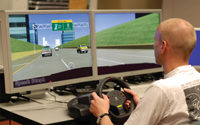UIC Researchers Apply Gaming Technology to Illinois Open Road Tolling Project
November 10th, 2006
Categories: Applications, Human Factors, Software

About
Over the summer, researchers at University of Illinois at Chicago’s Electronic Visualization Laboratory (EVL) developed a virtual driving simulator to evaluate alternative signage designs as part of a user study conducted by the Illinois State Toll Highway Authority (ISTHA) and consulting firm Wilbur Smith Associates (WSA).
Each toll plaza on the Illinois Tollway is announced by a quick succession of signs directing drivers to either manual pay or I-PASS (the Illinois Tollway’s electronic toll collection system) lanes; yet everyday many drivers juggling loose coins dangerously weave, switch lanes, or find themselves unwittingly routed through the I-PASS lanes and incurring a toll violation.
Unfamiliar or inattentive drivers account for most of these infractions, but ISTHA, now in the process of converting all twenty of its mainline toll plazas to Open Road Tolling (ORT) by the end of 2006, wanted a cheap and effective means to evaluate several advance signage options specifically for ORT toll plazas using a focus group of drivers. Previously, the Toll Authority built multiple physical signs for such user studies at great expense.
ORT allows vehicles with I-PASS transponders to proceed unimpeded through the toll plaza at highway speeds. Cash-paying vehicles are required to exit the mainline roadway, stop to pay a toll, and then merge back with the ORT lanes downstream of the plaza.
EVL’s tollway simulator modeled a high-resolution driving environment similar to an actual ORT plaza. Using a steering wheel designed for gaming environments, each driver was asked to navigate a virtual course displayed on a wide-angle display screen constructed of side-by-side LCD displays, and follow signage through the toll plaza. Test administrators could toggle among signs, incorporating diagrams, text, or a combination thereof. Drivers were then asked which signs best conveyed the required actions to be taken at the toll plaza. Several lighting conditions were also simulated such as bright sunlight, dawn, overcast and night.
“Recent advances in commodity gaming technology and high-resolution displays allowed us to create a realistic testing environment with acuity approaching 20/20,” said EVL co-director Jason Leigh, who is also an associate professor in the department of computer science. “Our goal was to enable ISTHA and WSA to elicit useful feedback on the signage, so the simulation had to mirror realistic driving conditions.”
The focus group consisted of commuters, infrequent travelers and commercial vehicle drivers. Over 30 people participated in the study over the course of three days in late August.
The tollway simulator was co-developed by computer science Ph.D. student Robert Kooima and Master of Fine Art student Kapil Arora. This technology can be applied to a wide range of other application areas, including driving simulators to train emergency responders in fire and police departments.
About EVL:
The Electronic Visualization Laboratory (EVL) at the University of Illinois at Chicago is a graduate research laboratory specializing in the design and development of high-resolution visualization and virtual-reality display systems, collaboration software for use on multi-gigabit networks, and advanced networking infrastructure. It is a joint effort of UIC’s College of Engineering and School of Art and Design, and represents the oldest formal collaboration between engineering and art in the country offering graduate MS, PhD and MFA degrees. EVL has received worldwide recognition for developing the original CAVE® and ImmersaDesk® virtual reality systems; and most recently the 105-Megapixel LambdaVision tiled display and Varrier autostereoscopic display. EVL is a founding member of StarLight and the Global Lambda Integrated Facility (GLIF), and with UCSD is a leading institution working on the NSF-funded OptIPuter project.